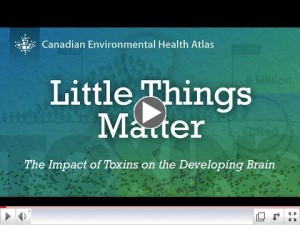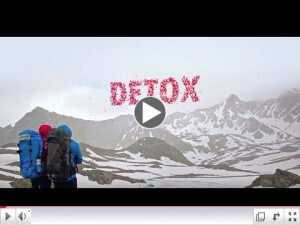March 2016: The Power of Prevention
In this edition:
- Remembering Berta Cáceres
- CBS reporter finds flame retardant “Tris” in daughter’s car seat and body
- Fluorinated chemicals in the news, from the US to the Land Down Under
- A perfect storm
- Are there batteries in your smoke detector?

I recently traveled to my home state of Arizona to meet with collaborators about improving the health of communities by transforming building materials used in affordable housing. We are delighted to have such diverse and knowledgeable partners in this three-year project, which includes our ongoing efforts to reduce the use of harmful flame retardants in building insulation where they are not needed for fire safety.
Scientists at California’s Department of Toxic Substances Control (DTSC) recently published a paper showing areduction of the flame retardant Penta-BDE in breast milk in California since the chemical was phased out in 2005. In spite of this decrease, the authors conclude that breastfeeding babies are still exposed to high levels of Penta and other PBDEs. Experts still recommend breastfeeding, but the presence of such toxics in breast milk clearly demonstrates that we need safer chemicals in products. As epidemiologist Bruce Lanphear explains, many chemicals, including PBDEs, have been shown to adversely impact neurological development.
The DTSC study provides evidence that exposures to humans and the environment can be gradually reduced by phasing out use of harmful chemicals. An even more powerful way to reduce health and environmental harm is by not using hazardous chemicals in the first place. The editorial in the March 11 edition of Science, authored by our Executive Director Arlene Blum, makes the case for reducing toxics through the Six Classes approach. A healthy population will require safer chemicals in products, and we believe retailers, manufacturers, purchasers, and scientists all play a role in “Tackling Toxics” to achieve this goal.
We discussed the Six Classes approach to safer chemicals in consumer products at our annual Flame Retardant Dilemma and Beyond meeting at UC Berkeley last month. You can view many of the presentations online.
Sincerely,
Avery and the Green Science Policy team
Remembering Berta Cáceres

We were deeply saddened to learn that Berta Cáceres, a winner of last year’s Goldman Environmental Prize, was murdered in her home in Honduras on March 3rd. She was 42 years old. Berta devoted her life to expanding rights for women, peasant farmers, and indigenous people, and protecting the land and natural resources. Honduras is the most dangerous country in the world for environmental activists. Following a military coup in 2009, Honduras “witnessed an explosive growth in environmentally destructive megaprojects that would displace indigenous communities.” Berta Cáceres led a peaceful campaign to stop four huge dams that would have cut off her people, the Lenca, from their land, water, food, and medicine. It put Berta and the other courageous members of her organization, COPINH, at odds with powerful forces, the Honduran government, army and police, and multinational corporations.
The Guardian reports that Berta’s name was at the top on an assassination list, and she was afraid. She said “I want to live, there are may things I still want to do in this world. I take precautions, but in the end, in this country where there is total impunity I am vulnerable. When they want to kill me, they will do it.” Reflecting on her life she once said, “I learned a lot, but also had to unlearn things. We have had to unlearn the oppressive message that as indigenous people we must just put up with things.” Berta Cáceres showed singular courage and inspired us all by refusing to just put up with things. She leaves behind her elderly mother and four children.
CBS reporter finds flame retardant “Tris” in daughter’s car seat and body

CBS News Investigative Journalist Julie Watts tested the “green certified” foam from her daughter’s car seat and also had her daughter’s levels measured.
Though the seat was marketed as free of harmful flame retardants, tests showed it contained a known carcinogen, chlorinated tris (or TDCPP), the flame retardant removed from children’s pajamas in the 1970s. You can view her interview with Arlene Blum here.
Julie replaced the car seat but made no other changes. Her daughter’s levels dropped from 60.08 parts per billion while she was using the car seat to 4.25 parts per billion 10 days later. It can be difficult to pinpoint a source of chemical exposure, but Dr. Martha Sandy, a toxicologist at OEHHA, said the “results suggest her car seat was the primary source of her exposure.”
Currently, car seats in the U.S. contain flame retardants to meet a federal flammability standard FMVSS 302, although a fire safety benefit has not been proven. However, when traveling, children must be secured in a properly installed car seat.
For now, parents can wash children’s hands with plain soap and water after being in the car and especially before eating; vacuum the car and car seat often; and limit the time a child spends in the seat to car time only, i.e. don’t leave baby in the seat when not in the car. Parents can have foam tested at Duke University.
Fluorinated chemicals in the news, from the US to the Land Down Under

Addressing tens of thousands of industrial chemicals one-by-one doesn’t work. Often, when a “bad actor” chemical is taken off the market a cycle of “regrettable substitutions” begins. Our Six Classes approach is a simple and effective way to stop the cycle. A series of knock-your-socks-off exposés has uncovered how this may be playing out with shorter chain highly fluorinated chemicals replacing C8, the chemical used to make Teflon and other products.
C8 is no longer produced in the US, but what is known about the C6s that have replaced it? In A Chemical Shell Game, The Intercept’s Sharon Lerner reports that the EPA has had “evidence of the health effects of DuPont’s C8 replacement, GenX, since at least April 2006.” DuPont’s experiments on lab animals, shows that GenX presents some of the very same health problems that C8 does, including changes in the size and weight of animals’ livers and kidneys, alterations to their immune responses and cholesterol levels, weight gain, reproductive problems, and cancer.”
This information on the toxicity of GenX was not shared with retailers and manufacturers who were assured of its safety and began using C6 in a wide variety of products. Our population is exposed to it on a daily basis from water- and stain-repellant products.
C8 has recently been detected in water in New York, Vermont, and Michigan. Read more about fluorinated chemicals in drinking water in Flint Residents May Have Been Drinking PFCs in Addition to Lead and Activists demand action against industrial chemical in water.
Two highly fluorinated chemicals “are now at the centre of a major water contamination investigation surrounding [an] Air Force base” in New South Wales, Australia. Investigators are working to determine if PFOS and PFOA spread from the “base into local ground and surface water.” Chemical Watch reports “Australia’s national chemicals agency, NICNAS, has recommended that industry phase out the use of per- and poly-fluorinated chemicals (PFCs) and actively seek alternatives.” NICNAS recommends restricting these and related chemicals to essential uses only, for example, PFOS-based fire-fighting foam should not be used for training purposes.
In related news, Chemical Watch reports that outdoor clothing companyPáramo “aims to remove 11 chemical classes of concern from its supply chain, including highly fluorinated chemicals” Páramo is among the first (and so far very few) outdoor apparel brands to join the Greenpeace Detox My Fashion campaign. You can learn about it in this short video.
A perfect storm

A perfect storm is “a critical or disastrous situation created by a powerful concurrence of factors.” It’s just the “right” factors leading to just the wrong outcome. High rates of exposure to organohalogenated flame retardants (OFRs) can be seen as a perfect storm that’s hitting all of us, but especially young children whose developing bodies and brains are more vulnerable to chemical exposure. Learn more here. Also learn why our Big Idea Petition calls on the Consumer Product Safety Commission (CPSC) to ban certain household products if they contain any OFRs in additive form.
Are there batteries in your smoke detector?

Have you ever removed the batteries from your smoke detector because it annoyingly went off while you were cooking or showering, or for no apparent reason at all? Good, functioning alarm systems can provide better protection from fires than flame retardants and do not expose us to hazardous chemicals.
Photoelectric smoke alarms are a more effective alternative than the commonly-used ionization smoke alarms – they detect smoldering smoke and do not give false alarms as frequently.
Photoelectric alarms are now required in Massachusetts, and data shows that there has since been a decrease in fire deaths. It is important to routinely check your smoke alarms to verify that they are functioning. If you have disabled your smoke alarms because of frequent nuisance alarms, you might want to consider installing photoelectric alarms.
Receive Updates By Email
Subscribe to our monthly newsletter and get these updates delivered right to your inbox!